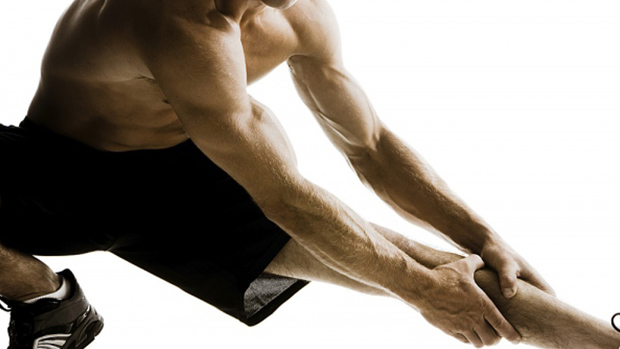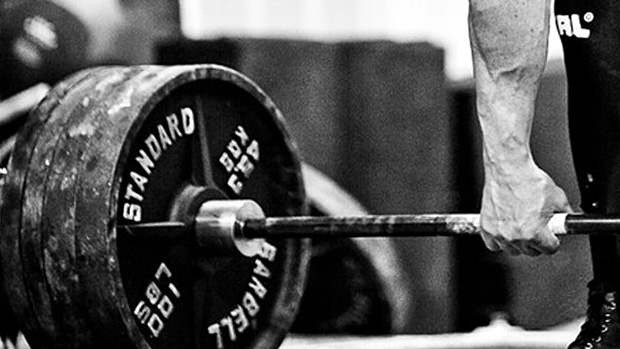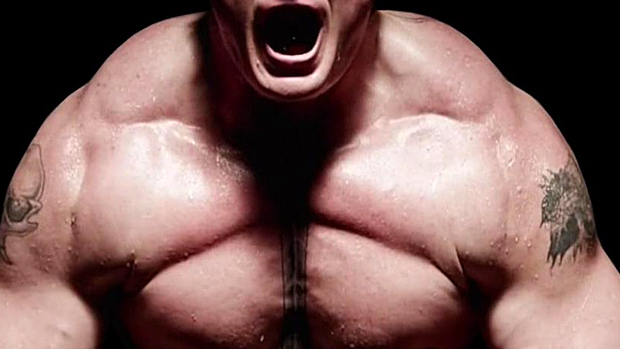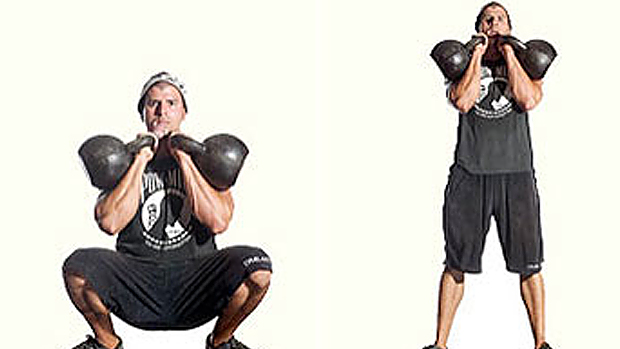In Part 1, I discussed the rationale for adding static stretching into your program. I also gave you some specific tips to improve the quality of your stretching workouts. Now, on with the program!
Now this wouldn't be a true flexibility article if I didn't give you some stretches to get you started. While the program given below is quite thorough, it doesn't stretch every single muscle group. As well, it doesn't allow for variety or individualization in your program. What I want to do is give you a program that'll get you started, and from there you can learn variations and techniques to keep your training fresh.
Beyond that, not every person is tight in the same area of the same muscle group. Expand your repertoire with stretches that give you the most benefit. Not only will your body respond to the new stimulus, but you'll be a lot less likely to fall off the flexibility wagon!
Gastroc

The calves are typically one of the most overactive muscle groups. Think about it, if you're an athlete, you only plantar flex your foot about 1000 times a day! Even if you're just on your feet a lot, these muscles tend to harbor a lot of tension.
To begin, pull the left toe up and press it against the wall. Keep the chest up and pull the torso close to the wall to get a mild stretch in the back of the lower leg. Hold, then repeat on the right side. If you want to stretch the soleus, flex the knee and repeat.
Hamstrings

Tight hip flexors and hamstrings are the result of our activity-resistant society. We sit for hours on end with our hip flexors and hammies in a shortened position, screwing up the length-tension relationship throughout the lower body. This stretch will focus on loosening up the hamstrings.
Stand up straight with the chest held high and the hands on the hips. From the starting position, push the butt back until you feel a mild stretch in the hamstrings. Make sure to keep an arch in the back throughout the stretch! Remember, we're stretching the hammies here, not the low back. Hold for 20 seconds and repeat.
Posterior Chain/Glute 1

A lot of the lower back injuries I see are due to excessive tension and poor ROM in the gluteal muscle groups. When the hips are bound up and tight, movements such as squatting and deadlifting are much more dangerous because the lumbar spine is forced into flexion as you increase flexion at the hip. Eric Cressey and I discussed the benefits of healthy hips in our Get Your Butt in Gear article series. This first stretch focuses on stretching the gluteus maximus.
Lie on your back and flex your right knee/hip to a 90 degree angle. From this position, use the left hand to pull the knee up toward the chest and across your body. Hold for 20 seconds and then repeat on left side
Piriformis/Glute 2

Beyond loosening up the glutes, another typically tight muscle group is the piriformis. Now bare with me for a second while I get geeky for you. Typically, the piriformis is an external rotator of the hip; however, as the hip moves past 60 degrees of flexion, it acts as an internal rotator. An excessively tight piriformis can cause impingement/irritation of the sciatic nerve, better known as Piriformis syndrome.
To stretch this muscle you didn't even know you had, flex your left knee/hip and keep your foot on the ground. Next, flex the right knee/hip and then externally rotate the leg, resting the ankle just below your left knee. Now, reach through the "hole" and place your hands on the back of your left leg. Pull your left leg into your body until you feel a mild stretch in the right hip. Hold for 20 seconds and then repeat on the opposite side.
Basic Quad

It's rare that people have just tight quads. Typically, it's a combination of really tight hip flexors and semi-tight quads. As well, excessive tension in the rectus femoris (the quad muscle that spans both the hip and knee joints), is far more common than excessive tension in the vastus muscle group. Nevertheless, tight hip flexors and quads will eventually ruin your knees. It's not a question of if, but when. Please stretch them!
Grab an object in front of you and flex your left knee. With the left hand, pull your left foot toward your butt until you feel a mild stretch in the front of your thigh. Hold for 20 seconds and then switch legs. Make sure to keep your chest up and try not to let your back arch while performing this stretch.
Upper Quad/Hip Flexor (Hip emphasis)

While the previous version focuses on the muscle belly of the quads, this version puts an emphasis on the upper portion of the quad. Start off easy here, as you'll probably get way more stretch than you bargained for!
Before you begin, place some sort of padding underneath the "down" knee. Take the toe of the left leg and place it on a chair, bench or low sitting couch behind you, and place your left knee on the padding. Take the right leg out in front of you as if you were lunging.
From this position, let the hips sink down and forward until you get a mild stretch in the front of the left hip. Hold for 20 seconds and then repeat on the opposite side. It may help to have a chair or table next to you while stretching. Instead of fighting to keep your balance, you might be able to focus on the stretch instead!
Basic Hip Flexor

Now that we've loosened up the quads, it's time to focus on the hip flexors. This is probably the single-most overactive group of muscles, and the benefits of stretching them are numerous: improved firing of the gluteals, decreased incidence of low back injury, etc.
This stretch is identical to the one described before, except your back leg isn't elevated in this version. To increase the stretch on the psoas versus iliacus, laterally flex the body in the opposite direction of the side you're stretching (e.g. if you're stretching the right hip, laterally flex to the left).
Adductors

Ever had a groin strain or tear? It sucks, believe me. Not only is this area super sensitive, but it also doesn't get much blood flow, making rehab a time-consuming process.
To stretch the adductors, sit flat on the floor with the legs spread comfortably apart. Shift your weight forward, keeping your chest up until you get a mild stretch on the inner part of your thigh. Hold for 20 seconds, relax, and then repeat.
Lumbar Spinal Erectors

A while back I was looking for a solid low-back stretch that didn't involve flexion of the spine. I think toe touches and supine knee-to-chest stretches are great, but they simply can't be utilized by all populations. This version is applicable to a wider range of people and can also address unilateral imbalances in flexibility in the spinal erectors.
Lay flat on your back with your legs together and straight. To get into position, flex the right hip/knee to 90 degrees, and then take the knee all the way to the ground on the opposite side. Use the left hand to hold the knee down, and then reach back with the right arm to stretch the spinal erectors. Hold for 20 seconds and then repeat on the opposite side.
Thoracic Spinal Erectors

While the previous stretch gets more in the lumbar region of the erectors, this version hits more in the mid-back/thoracic region. It doesn't really make sense to stretch one area and not the other, as the erectors are a long group of muscles spanning from the hips up to the base of the skull.
To stretch the thoracic area erectors, sit on the floor with the legs extended out in front of you. Flex the right knee and cross it over the left leg so the foot is resting on the ground. Bend the left arm and place the elbow on the outside of the knee. From here you can push off the elbow to increase the amount of rotation and stretch. Hold for 20 seconds and then repeat on the opposite side.
Pecs

The pecs and lats are to the upper body what the hip flexors and hamstrings are to the lower body. Both are shortened each and every minute we sit on our arses at a computer.
Using a doorway or post, bend the right arm to 90 degrees and place the lower arm and hand along the length of the doorway. From the starting position, twist the hips in the opposite direction until you get a mild stretch in the chest. Hold for 20 seconds and then switch arms.
Lats

Much like the pecs, the lats are major internal rotators and need to be stretched. If you're like me, you love to train back, especially heavy chin-ups and pull-ups. If this is the case, you really need to make sure you're stretching your lats out. Not only will it improve your posture, but you'll be pressing more weight for more years as well.
Stand up straight with the chest held high and the hands on something just above hip height. From the starting position, push the butt back until you feel a mild stretch along the sides of the back. Hold for 20 seconds and repeat as necessary. This can also be done one arm at a time if you've noticed you have one side that's significantly tighter than the other.
Triceps

The triceps are used in virtually every pressing exercise, so at least some static stretching is necessary to return them to an appropriate resting length.
In a standing or seated position, flex the shoulder and bend your elbow to a point where your elbow is actually pointing straight up toward the ceiling. From here, take the opposite arm and pull the elbow even farther back until you get a pull in the back of your upper arm. Hold for 20 seconds and then repeat on the opposite side.
Upper Traps/Sternocleidomastoid (SCM)

Most of you probably haven't heard of your SCM, but I assure you it can be a real pain in the ass if it's overactive or tight. This can lead to several postural issues such as a head forward posture and tension headaches.
To stretch the SCM, sit in a chair with good erect posture and hook the fingers of your right hand underneath. With your left hand, gently pull your left ear toward your left shoulder (straight across). Hold for 20 seconds and then repeat on the opposite side.
Suboccipitals

The suboccipitals are a very small muscle group that lies on the back of your neck near the base of your skull. Much like the SCM, overly tight suboccipitals can lead to forward head posture issues: headaches, excessive dry mouth, difficulty swallowing, and general tightness in the neck.
Sit or stand with good erect posture. Tuck the chin in slightly, and then lace your finger tips on the back of your head. Gently pull the head forward until you feel a stretch in the back of your neck, right at the base of your skull. Hold for 20 seconds, relax, and then repeat.
You do all the right things to help improve your performance. You train hard, eat and supplement your diet with the best products, and recover like it's a part-time job. You should stretch too.
Stretching is not only extremely simple, but cost effective as well. Doesn't it make sense to take a few minutes out of your day to help keep you hitting the iron? Sure, you're probably not going to hear people say, "Wow, you have great quad flexibility!" but if it keeps you healthy and on the road to success, does it really matter?
Now if you'll excuse me, I've been sitting as this computer way too long. I need to go stretch!





